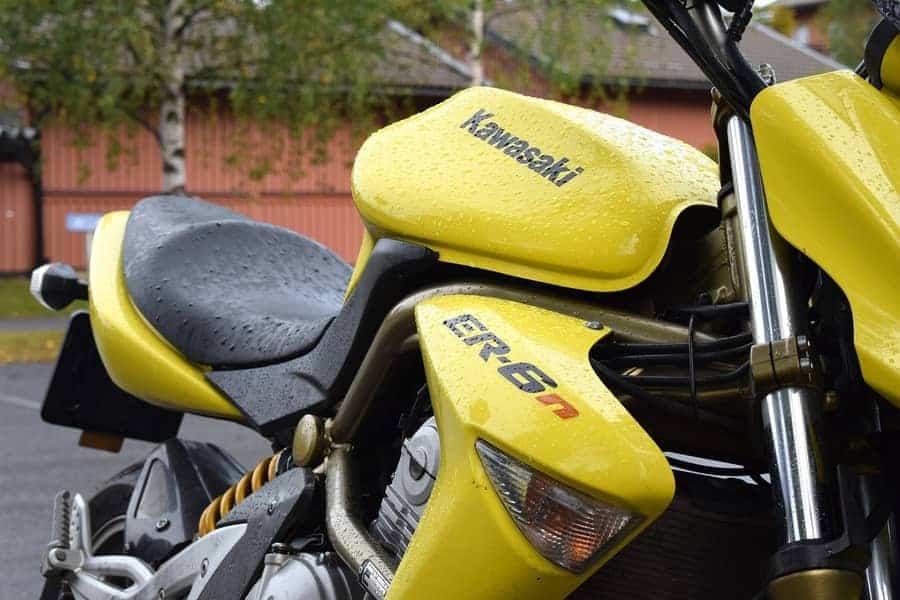A warm sunny day is every motorcycle rider’s best friend. Every time winter or the rainy season comes, a lot of riders would wait in agony for cloudless skies.
Some riders refuse to ride in the rain and think that riding in the rain is suicide. But other riders, like me, brave slippery wet roads to feel the atmosphere, see the space, and to hear the grip of the tires on the wet surface. This, some would say, is the fuller experience of riding.
Riding in the rain doesn’t come with its own set of risks. Visibility and traction are cut in half, the road turns into a wet killer gauntlet, and your lovely bike feels like a death machine more than ever.
But riders shouldn’t stop riding just because of a little weather. Bikes are freedom, and there are few things more liberating than being prepared to ride in the rain.
Tip 1: See lightning? Stop
Take cover! Lightning usually hits anything that pops out of a flat surface. You on a motorcycle will be a little bit taller than most sedans so it’s best to take shelter if you see lightning nearby.
Tip 2: Stand up!
Again, this might seem dangerous, but standing up while riding in the rain every once in a while would not only get a little bit of blood pumping, it would also get rid of the water that’s been pooling up on your rain gear. Less water, less leaks, more time riding.

Tip 3: Be seen
Gearing up in black is cool. But you know what’s cooler? Safety. It’s obviously a no-brainer to always be seen riding your bike, but when the rain starts, you become almost invisible.
It’s low flat light every time it rains so if you’re riding around in blacked-out waterproof gear, it doesn’t make a lot of sense. You should be as bright as a highlighter pen when riding in the rain and wearing rain gear that burns car drivers’ retinas out helps.
If you know the rainy weather is coming, it’s also best to add a few auxiliary lights to help you be more visible to other drivers. If they can see you, they’ll be less likely to run you over.
In addition to that, you could add some extra reflective stickers and decals (check my complete guide), so that other road users will see you in these terrible conditions.
Tip 4: Distance yourself from cars
Not only would this give you more braking distance, but this would keep you away from the plash of their tires. Any rider who has drifted to close to a car in the rain knows what four wheels spinning dirt and mud will do to a motorcycle.
Tip 5: Stay away from rainbows
If you’ve ever ridden in the wet and seen a puddle with rainbow colors, avoid them. That isn’t a sign from the heavens above that the rain is going to stop soon. That’s oil. “Oil”, “Road”, “Wet”, and “Motorcycles” are four words you’d never want to use in a sentence.
Tip 6: Frog togs
Sadly, even the world’s best rain gear will still leak after a while. That’s why it’s best to get a dedicated raincoat or rain shell like frog togs. These are great because they only have one job and that’s to keep the water out and to keep you dry. When it comes to the effectiveness and longevity of use, nothing beats frog togs or raincoats.
Tip 7: Rain gear life hacks
If you know the rainy season will be coming up soon, it’s always best to prepare for it. Bring out your waterproof gloves, your waterproof jacket, and your frog togs.
But what if, like me, you’re cheap and don’t want to spend a fortune just to ride in the rain? Well, here are a few life hacks for the cheapos who love riding in the rain:
- Dandruff shampoo or shaving cream on your visor – Anti-fog coating worn off on your visor? Revitalize it with a layer of dandruff shampoo or shaving cream. Just lay a thin layer on your visor, let it dry, then buff it out. Dandruff shampoo and shaving cream has hydrophobic components which make water want to spread out rather than clump together and form fog.
- Need a cold weather jacket? Get newspapers! Stuff your old jacket with newspapers for the cold weather. This will create lots of air pockets in your jacket and trap hot air to keep you warm. Newspaper will also do a good job absorbing any leaking rainwater before it gets to you.
- Open helmet vents to prevent fogging! This sounds counterintuitive because, of course, you want to stay as dry as possible. Being able to see the road is much more important than staying dry. Keeping your vents closed in the rain will fog up your helmet.
- Cold and wet gloves? Put some rubber gloves on! This won’t be your best bet against the cold but if you want hands that are dry throughout your ride, put on a pair of thin rubber work gloves under your regular riding gloves.
- Caught in a cloud burst and need to get your wet boots through your rain pants? Put a plastic bag over your boots and they’ll slide right through.
- Use a yellow pin lock visor. Riders love the physics-defying anti-fog qualities of a pin lock visor. Fog is a huge culprit in the rain but using a yellow visor will help with visibility. Yellow increases contrast on the road and will help you see better in low light.

Tip 8: Carrying stuff in the rain
Luckily, almost all motorcycle bags come with some sort of waterproofing and a huge chunk of motorcycle bags, from saddlebags, to backpacks, are waterproof. Want to know the best luggage to carry with you in the rain? Check out the Best Motorcycle Leg Bags and the Best Motorcycle Backpacks
Tip 9: Maintain your waterproof jacket
It always helps to be prepared for whatever’s coming and a clever rider would know that if the season’s changing, they and their bike should change along with it. Preparing for the rain will always help you ride better with confidence and in turn, will make you a better overall rider.
The best rain gear any rider can get is still the one he or she is already wearing—a waterproof jacket. Any rider, at one point of their lives, has spent a lot of money on a waterproof jacket, used them until they leaked, threw them out, and bought new ones.
Throwing away waterproof gear because they’re leaking is like throwing away a pencil because the tip has broken off. Waterproof riding gear needs to be maintained. Get yourself some waterproof fabric protector that will increase waterproofing in your jacket. There are lots of fabric protectors in the market and any one of them will be suitable.
Tip 10: Get good tires
If you know the rainy season’s coming, put on rain tires. This is an obvious tip that a lot of riders seem to miss or not be mindful of. Some riders actually make the mistake of riding their summer tires well into the rainy season and that’s the perfect recipe for disaster.
Tip 11: Be patient
Whether you got caught in a freak rainstorm, or you want to see what it would feel like riding in the rain, there are things you should pay attention to and take note of before and during your wet adventure.
The most dangerous part about riding in the rain is just after it starts. During the first half hour or so, oil, dirt, gunk, and muck on the road float up and are still getting washed away by the rain. These are super slippery and would be best to wait until these have gone.
Tip 12: Lane position

Pick a good line on the road to ride in. Car tires move water out of the way so it’s best to ride on a part of the road where car tires have driven through. This is usually the safest and driest part of the road. Stay away from the middle of the road. This is where all the oil and dirt accumulates. It is also usually the wettest part of the road.
Keep in mind that your position should always be predictable and you should make sure you’re being seen by other traffic. You can read more about that in my article about being noticed in traffic.
Tip 13: Avoid puddles
Avoid puddles at all costs. You don’t know what they’re hiding under the water and you don’t know how deep a puddle might be. Pair decent pavement and decent tires in the rain and you would get almost the same traction as you would in the dry but even the best tires in the world can aquaplane (check this Youtube video).
This happens when enough water gets between your tire and the road that you actually start “floating” on the road. This would almost certainly leave the bike with zero traction. At fast enough speed, even a three-inch deep puddle would be enough to get you to aquaplane.
Painted covers and manhole covers are also slipperiest when wet and would be best to avoid them at all costs.
Tip 14: Relax and slow down
Being tense while driving will make you dangerous on your bike. Rather than maintaining speed and being scared the heck out of your mind, slow down. This will calm you down. Calm means focused and focused means safe.
Tip 15: Increase lean
No, I don’t mean you should challenge Rossi to a one-on-one in the rain. Don’t increase the bike’s lean, rather, increase your body lean on the bike. Leaning out more than you have to might make you look silly but it also makes you safer. Leaning out more means the bike can stay a little bit more upright which means more tire is gripping the road.
Tip 16: Take lots of breaks and get warm
There’s no use impressing your buddies how long you were riding in the rain if you can’t live to tell the tale! If it’s too cold, take a break, get a cup of coffee and warm up. The goal is not to be the best rider in the rain, the goal is to get home safely in one piece.
